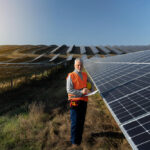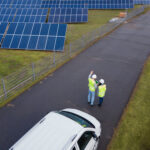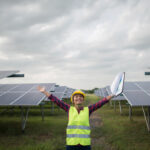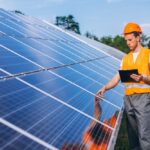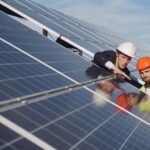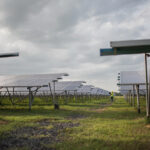As the world continues to shift towards renewable energy sources, solar farms have become an increasingly popular option for generating electricity. However, developing and maintaining a solar farm can be a costly endeavor, which is why a solid financial model is essential for investors and project developers. In this blog post, we will explore solar farm financial model and provide insights into how to create one that accurately reflects your project’s financials.
Key Components of a Solar Farm Financial Model
Revenue Streams
The first and most critical component of a solar farm financial model is revenue streams. Solar farms generate revenue through the sale of electricity, and there are several ways to structure these revenues. The most common way is through a power purchase agreement (PPA), where the solar farm sells electricity to a utility company or a large corporation at a fixed rate over a long period, typically 20-30 years.
Another revenue stream for solar farms is through the sale of renewable energy certificates (RECs). RECs are certificates that represent the environmental attributes of one megawatt-hour of renewable energy. Utilities and corporations buy RECs to meet their renewable energy targets and offset their carbon emissions.
It’s important to note that the revenue streams for a solar farm can vary depending on the location and size of the project. For example, a small solar farm may not be able to secure a PPA and may instead sell electricity directly to the grid at spot prices. A larger solar farm, on the other hand, may be able to negotiate a better PPA with a utility company.
Cost Structure
The next crucial component of a solar farm financial model is the cost structure. Developing and operating a solar farm comes with several costs, including:
Development costs: These include the costs associated with finding suitable land , obtaining permits, and designing the solar farm.
Construction costs: This includes the cost of equipment, labor, and installation.
Operating expenses: Ongoing expenses such as maintenance, repair, and monitoring.
Financing costs: Interest payments on loans taken out to finance the project.
To create an accurate financial model, you need to estimate each of these costs carefully. It’s also essential to consider the timing of these costs, as they may occur at different stages of the project’s development.
Tax Benefits
Tax benefits can significantly impact the financial performance of a solar farm. The federal government offers various tax incentives for renewable energy projects, such as the Production Tax Credit (PTC) and the Investment Tax Credit (ITC). These credits can help reduce the project’s tax liability, thereby increasing its profitability.
State and local governments may offer additional tax incentives, such as property tax abatements or sales tax exemptions. It’s essential to research and incorporate all relevant tax benefits into your financial model.
Debt Financing
Debt financing is a crucial aspect of solar farm development, as it allows developers to cover upfront costs such as land acquisition, engineering, procurement, and construction (EPC). The financial model should include details of the loan amount, interest rate, loan term, and repayment schedule.
The debt financing section of the financial model should also take into account the fees associated with the loan, such as origination fees, commitment fees, and prepayment penalties. Additionally, the model should consider the impact of inflation on the loan repayment schedule and interest rates.
Cash Flow Analysis
A comprehensive cash flow analysis is essential to understand the financial viability of the solar farm project. The cash flow analysis should include the following components:
Revenue: The revenue stream from the sale of electricity generated by the solar farm, taking into account the PPA or spot market pricing, and any revenue from RECs or other incentives.
Expenses: The operational expenses, including maintenance, repair, and monitoring costs, as well as any overhead expenses such as management salaries and office rent, throughout the time to build a solar farm.
Capital Expenditures: The initial investment in the project, including the cost of land requirements for solar farm, EPC, and any upgrade or replacement costs during the life of the project.
Working Capital: The working capital requirements, including the cost of spare parts inventory, accounts receivable, and accounts payable.
The cash flow analysis should also consider the impact of taxes, depreciation, and inflation on the project’s financials. The goal of the cash flow analysis is to determine the net present value (NPV) of the project, which represents the total value of the project’s expected future cash flows discounted to their present value.
Sensitivity Analysis
A sensitivity analysis is a useful tool to assess the impact of changes in certain variables on the project’s financial performance. The solar farm financial model should include sensitivity analyses to evaluate the effect of variations in factors such as electricity prices, panel efficiency, and interest rates.
For instance, a sensitivity analysis could show how a change in electricity prices would affect the project’s revenue and profits. Similarly, a sensitivity analysis could demonstrate how a change in interest rates would impact the project’s debt financing costs and overall financial performance.
Risk Analysis
Risk analysis is an essential part of any financial model, as it helps investors and developers identify potential risks and mitigations. The solar farm financial model should include a risk analysis section that considers various risks, such as:
Technical Risks: Equipment failure, panel degradation, and unexpected changes in weather patterns.
Regulatory Risks: Changes in government policies, regulatory frameworks, and subsidy programs.
Market Risks: Fluctuations in electricity demand, competition from other energy sources, and changes in market conditions.
Financial Risks: Default on debt obligations, currency fluctuations, and inflation.
The risk analysis section should also outline strategies to mitigate these risks, such as diversifying revenue streams, implementing hedging strategies, and maintaining contingency funds.
Conclusion
A comprehensive solar farm financial model is critical to the success of your renewable energy project. By following the steps outlined in this post, you can create a robust plan that takes into account various factors, such as project size, location, and financing options. A well-structured financial model will not only help you secure funding but also ensure that your project stays profitable in the long run.


